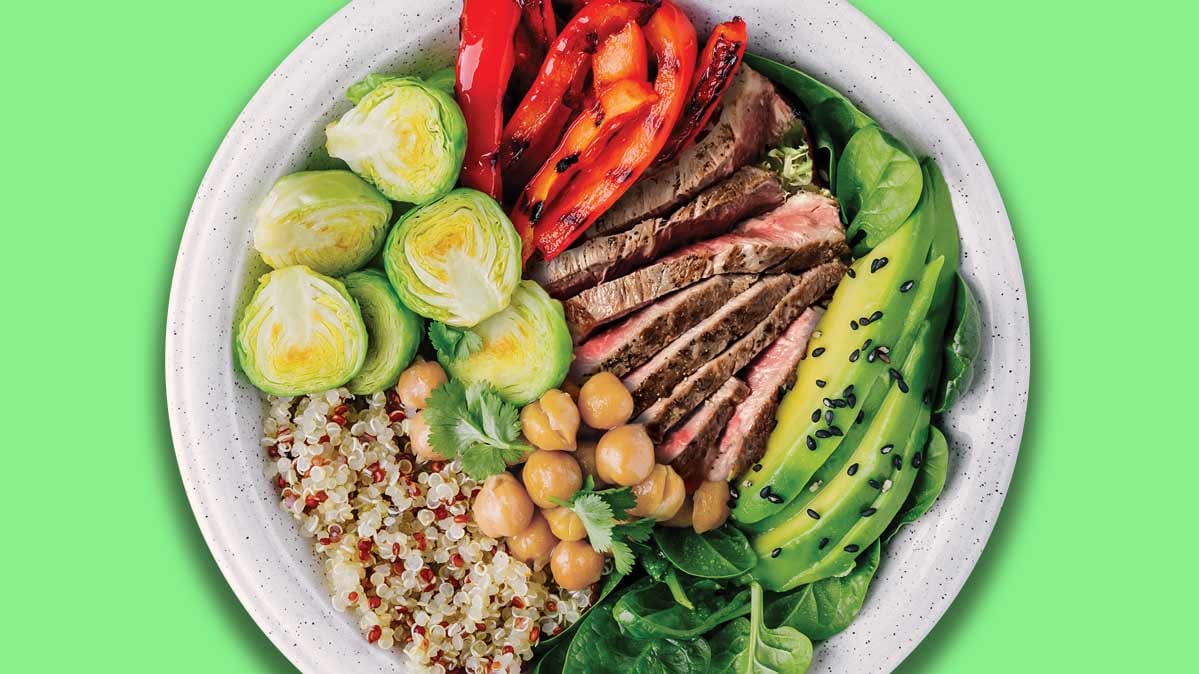
“Meat can be part of a healthy diet as long as you don’t make it the biggest thing on your plate,” Levitsky says. Here’s how to enjoy your meat and keep an eye on your health:
1. Choose less fatty cuts. When buying red meat, look for cuts labeled “lean” (see “6 Lean Cuts of Red Meat,” below). If your meat has marbling (fat), trim off as much as you can before cooking it. Baking, braising, and stewing can be healthy ways to cook meat without having to add butter, oil, or tons of salt.
2. Give it a supporting role. “The newest U.S. Dietary Guidelines took into account that you can’t just say ‘eat less of that.’ They suggest you have to shift from this to that,” Gardner says. When you reduce the amount of meat you’re eating, replace it with plant foods. Instead of a big filet with a side of potatoes and broccoli, put vegetables, beans, and whole grains center stage. When you eat meat, it should take up just one-quarter of your plate. In general, having a few 3 1/2-ounce portions of lean red meat per week seems reasonable from a health perspective.
3. Consider organic and/or grassfed. When you’re eating smaller portions, you can justify paying more for better quality meat. Many animals are treated with hormones and antibiotics that can have an effect on humans, including contributing to antibiotic resistance. Organic cattle and pigs can’t be given antibiotics, and organic cattle aren’t given hormones. (No pigs, not even conventionally raised, can be given hormones.) For beef, the American Grassfed Certified seal guarantees it came from animals that were raised in pastures for their entire life instead of being confined to feedlots, and were not given antibiotics or growth hormones. However, while grassfed beef is leaner, it isn’t significantly more nutritious, Levitsky says.
4. Grill smarter. Cooking meat at high temperatures, such as frying or grilling, creates compounds that may cause cancer, says Catherine Carpenter, Ph.D., professor of medicine, nursing and public health at UCLA’s Center for Human Nutrition. To minimize their formation, she cooks meat away from the flame, turning it frequently so that it doesn’t get charred and removing the burnt parts before eating. Pair grilled meats with fruits and vegetables, which contain antioxidants that counteract the carcinogens. Marinating in oil and an acid, such as lemon or lime juice, before cooking may also help prevent these compounds from forming.
5. Skip processed meats. There’s a trifecta of reasons to minimize your intake of deli and cured meats (ham, bacon, hot dogs, salami, and jerky). They’ve been linked with cancer in several studies, says Carpenter, they tend to be high in sodium, and deli meats are prone to contamination with the bacteria listeria. Instead, Carpenter suggests using pork tenderloin, chicken breast, or another cooked fresh meat for sandwiches and salads.
6. Add in substitutes. Foods that have a savory or umami flavor can impart a meaty taste. Thick and filling, portobello mushrooms can do almost anything meat can. Try grilling them—just marinate first so that they don’t char. (One cup has about 4 grams of protein.) Beans, such as kidney or cannellini, tofu, and tempeh are versatile and high in protein. And using small amounts of aged cheese (such as Parmigiano-Reggiano or Gouda) in dishes adds umami flavor and creaminess.
"Meat" - Google News
January 05, 2020 at 06:01PM
https://ift.tt/2FiLb6K
A Meat Lover's Guide to Healthy Eating - ConsumerReports.org
"Meat" - Google News
https://ift.tt/2XaYM8n
Shoes Man Tutorial
Pos News Update
Meme Update
Korean Entertainment News
Japan News Update
Bagikan Berita Ini















0 Response to "A Meat Lover's Guide to Healthy Eating - ConsumerReports.org"
Post a Comment